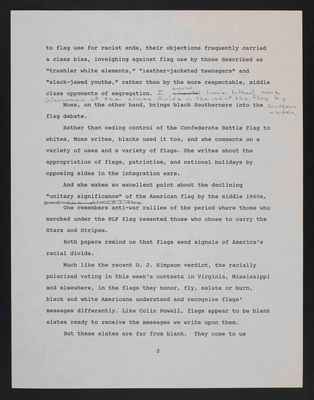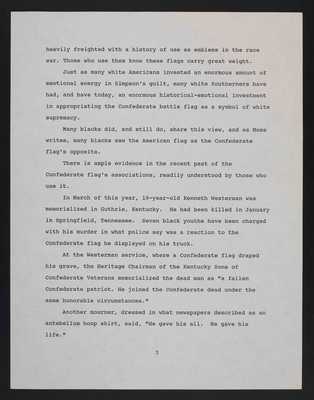Pages
1
Southern Historical Assocation New Orlean, La. November 10, 1995 by Julian Bond
Last Sunday's New York Times reminds us how powerful and the memories they evoke are. An article describes how the integrated rock group Hootie and the Blowfish was denied South Carolina's coveted Palmetto Award because their black lead singer, Darius Rucker, objected to the Confederate flag flying over the state capitol.
Reverence for the past, and disagreement over what that past is, is central to the papers presented here,
These two papers focus on flags - in Coski, the Confederate Battle Flag flies high; Moss raises both it and the Americn flag.
Both write about these flags as symbolic and real standards, expressions of ideology confiscated in the context of arguments over race.
Coski states early on that he will not address the schizophrenic disconnect between many flag defender's insistence that the Confederate banner did not celebrate a defense of slavery and a "rebellion" against the United States and that the Civil War" had no inherent link to racial issues" and the reality of a war fought to preserve slavery.
Instead, he traces "the emergence of the flag as a visible symbol in American life" to its"reuniting" in 1948 and the Dixiecrat movement with its ideological roots.
He notes that while flag preservationists sometimes objected
2
to flag use for racist ends, their objections frequently carried a class bias, inveighing against flag use by those described as "trashier white elements," "leather-jacketed teenagers" and "slack-jawed youths," rather than by the more respectable, middle class opponnets of segregations. I would have listed more disscussion of the class divide in the use of the flag by the sounthern whites. Moss, on the other hand, brings black Southerners into the flag debate. Rather than ceding control of the Confederate Battle Flag to whites, Moss writes, blacks used it too, and she comments on a variety of uses and a variety of flags. She writes about the appropriation of flags, patriotism, and national holidays by opposing sides in the integration wars. And she makes an excellent point about the declining "unitary significance" of the American flag by the middle 1960s, and the places the One remembers anti-war rallies of the period where those who marched under the NLF flag resented those who chose to carry the Stars and Stripes. Both papers remind us that flags send signals of America's racial divide. Much like the recent O.J. Simpson verdict, the racially polarized voting in this week's contests in Virginia, Mississippi and elsewhere, in the flags they honor, fly, salute or burn, black and white Americans understand and recognize flags' messages differently. Like Colin Powell, flags appear to be blank slates ready to recieve the messages we write upon them. But these slates are far from blank. They come to us
3
heavily freighted with a history of use as emblems in the race war. Those who use then know these flags carry great weight. Just as many white Americans invested an enormous amount of emotional energy in Simpson's guilt, many white Southerners have had, and have today, an enormous historical-emotional investment in appropriating the Confederate battle flag as a symbol of white supremacy. Many blacks did, and still do, share this view, and as Moss writes, many blacks saw the American flag as the Confederate flag's opposite. There is ample evidence in the recent past of the Confederate flag's associations, readily understood by those who use it. In March of this year, 19-year-old Kenneth Westerman was memorialized in Guthrie, Kentucky. He had been killed in January in Springfield, Tennessee. Seven black youths have been charged with his murder in what police say was a reaction to the Confederate flag he displayed on his truck. At the Westerman service, where a Confederate flag draped his grave, the Heritage Chairman of Kentucky Sons of Confederate Veterans memorialized the dead man as "a fallen Confederate patriot. He joined the Confederate dead under the same honorable circumstances." Another mourner, dressed in what newspapers described as an antebellum hoop skirt, said, "He gave his all. He gave his life."
4
And one speaker from the racist, anti-semetic Southern League, Inc. decried "brown-shirted street thugs" and warned of "mongrelized multi-culturalism." The League, of course, celebrates an exclusively white and Christian South, flying under Confederate banners, putting a happy face on the politics of racist rage, and in a reminder of costist class divide, represents a class step upward, Also in March, the Chairman of the Virginia Republican Party defended his attendance at a Confederate Flag Ceremony. "If I worried about the message, the impressions, I woudn't do anything," he said. "It's the right thing to do." I would have wanted Coski to provide deeper examination of the escalated embrace of the Confederate flag by integration opponents after Brown v Board of Education in 1954 and during the period of massive resistance which followed. Perhaps time and length constraints did not allow for a closer examination of the relationship between Coski's Confederate flag and the occasions where it is displayed and the reactions of those who saw it. Central to both papers is the questions of whether symbols of the past can be seperated from the past they represent. I would argue that they cannot, and invite this audience's attention to Driving Dixie Down: Removing the Confederate Flag from Southern State Capitols in the Yale Law Journal by James Forman, Jr. Forman, the son and namesake of the noted civil rights activist, argues that removing the Confederate flag from state
5
capitols, at least, is constitutionally required. Forman closes his article with a reminiscence of his high school days in Atlanta when his homeroom seat allowed him a view of the school caretaker raising the Georgia State Flag. "I am drawn to this flag, particularly its wholesale incorporation of Dixie. I observe the same scene almost every morning, and almost every morning I hate the fact that I watch. I want to desperately to ignore the flag, ignore Dixie, and ignore the history for which it stands." "For relief, I take my eyes off the flag and glance down again at the groundskeeper, who is still pulling the cords to the groundskeeper is black. I think of the incongruity of having black children, in a largely black city, watch a black man raise the symbol of the Confederacy for us all to honor. I tell myself to laugh, hoping that this will keep me from crying. But I forget. If I could just forget. My eyes close tightly, my fists clench, and I slowly force from my eyes images of the flag, of people in chains, hanging from trees, kept illiterate, denied the opportunity to vote." "The bell has rung. My teacher is calling my name: "James, are you ok?" I look up startled. "Yes ma'am, I'm fine," I say, to myself as I walk out the door. I have forgotten; I have purged my mind; I am able to get up and walk out of the door. But overcoming the flag has taken a piece of me - a piece that I wil not easily recover." 1 1. James Forman, Jr., "Driving Dixie Down: Removing the Confederate Flag from Southern State Capitols" The Yale Law Journal, Volume 101, Number 2, (November 1991,) New Haven.




